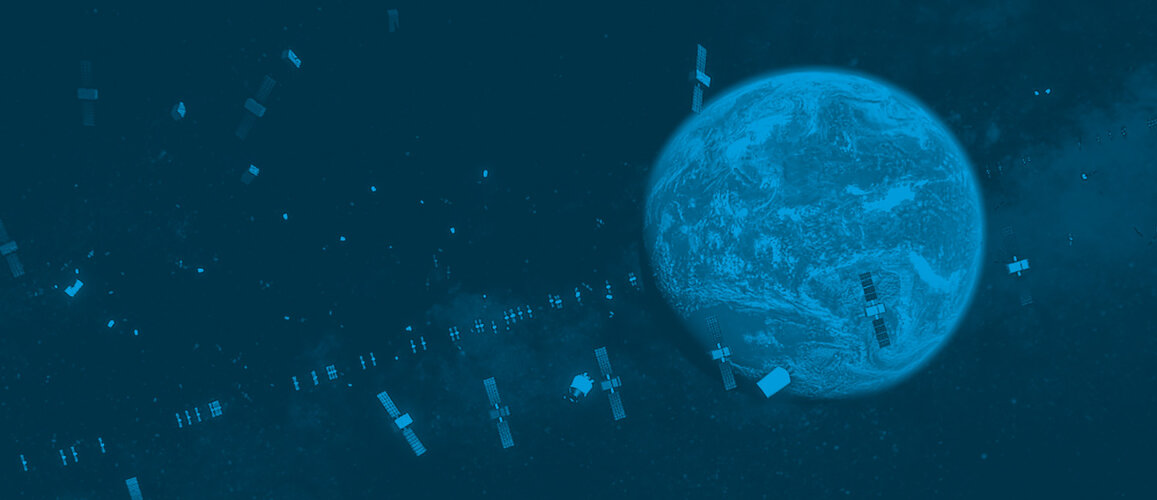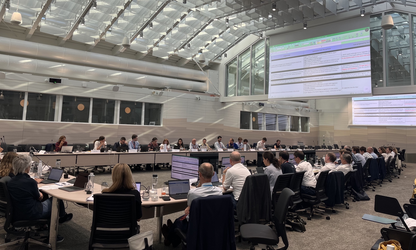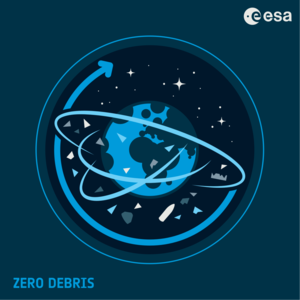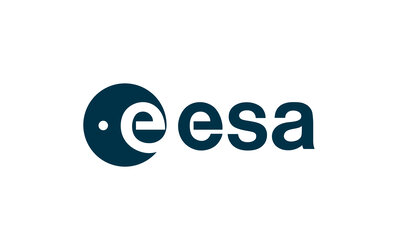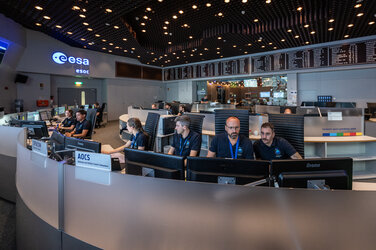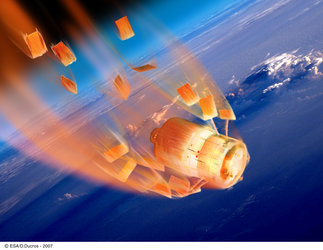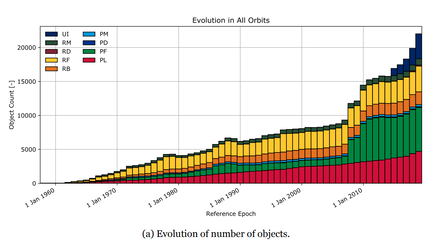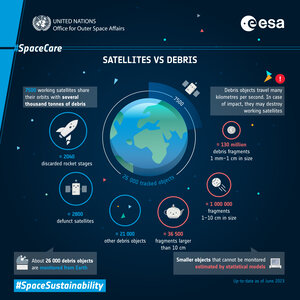ESA Space Environment Report 2024
In brief
Our planet is surrounded by spacecraft carrying out important work to study our changing climate, deliver global communication and navigation services and help us answer important scientific questions.
But some of their orbits are getting crowded and increasingly churning with deadly, fast-moving pieces of defunct satellites and rockets that threaten our future in space.
In 2002, the Inter-Agency Space Debris Coordination Committee (IADC), of which ESA is a member, published their Space Debris Mitigation Guidelines. The measures described in the voluntary guidelines set out how to design, fly, and dispose of space missions in ways that prevent the creation of further debris. They were a major step for the protection of our important orbits and have served as the baseline for mitigation policy at ESA and beyond, national legislation and technical standards for two decades.
Since 2017, ESA’s Space Debris Office has published an annual Space Environment Report to provide a transparent overview of global space activities and determine how well these and other international debris-reduction measures are improving the long-term sustainability of spaceflight.
Below is an overview of the 2024 report.
The basics
- Earth’s orbital environment is a finite resource.
- More satellites were launched in 2023 than in any year before.
- The number and scale of commercial satellite constellations in certain low-Earth orbits continue to increase.
- Not enough satellites leave these heavily congested orbits at the end of their lives.
- Satellites that remain in their operational orbit at the end of their mission are at risk of fragmenting into dangerous clouds of debris that linger in orbit for many years.
- Active satellites must perform an increasing number of collision avoidance manoeuvres to dodge out of the way of other satellites and fragments of space debris.
- The adoption of space debris mitigation measures is slowly improving, but it is still not enough to stop the increase of the amount of space debris.
- Without further change, the collective behaviour of space-faring entities (private companies and national agencies) is unsustainable in the long term.
In-depth
Most trends continue

The amount of space debris grows
The amount of space debris in orbit continues to rise quickly. Some 35 000 objects are now tracked by space surveillance networks. About 9 100 of these are active payloads, the other 26 000 are pieces of debris that are larger than 10 cm in size.
However, the actual number of space debris objects larger than 1 cm in size – large enough to be capable of causing catastrophic damage – is over one million.

The steep upwards trend in the number of satellites being launched continues
In 2023, payload launch traffic was again the highest ever, with most satellites becoming part of large commercial communication constellations.

Low-Earth orbit gets ever more crowded
Within low-Earth orbit, there are preferential altitude ranges for communication constellations, which show a clear peak in satellite concentration as a result.
Two-thirds of all active satellites, over 6 000, are currently located between altitudes of 500 and 600 km. This trend will continue as most newly launched satellites in 2023 were also heading to these orbits.

Making evasive action unavoidable
Any collision or explosion creating large number of debris pieces would be catastrophic for all satellites sharing a busy orbit – as well as for all spacecraft having to pass through these orbits.
Across low-Earth orbits, the number of events triggering collision avoidance procedures is increasing, partly because of the growing traffic congestion, partly because of the increasing amount of debris.
Mitigation efforts on the rise

Reentries show positive trend
In absolute terms, the number of objects reentering Earth’s atmosphere in 2023 went down. This is mostly because of the reentry of debris caused by a specific anti-satellite missile test at the end of 2021 peaked in the previous year (PF in light blue).
However, efforts to improve compliance with space debris mitigation guidelines to remove satellites at the end of their lifetime from important orbits have intensified. This has lead to a rapid rise in the number of satellites reentering the atmosphere (PL in dark blue).

More reentries of payloads and rocket bodies
Both rocket bodies and payloads are reentering in greater numbers year-on-year. This can partly be contributed to increased efforts to follow debris mitigation guidelines.
Another factor this year, and one that will continue to play a role for the next few years, is the high level of solar activity caused by the peak in the current solar cycle. This period of intense space weather events can often cause increase atmospheric drag, which contributes to accelerated reentry times.
The number of rocket bodies returning in a controlled manner is a particular area of improvement. About 90% of rocket bodies in low-Earth orbits are now leaving valuable orbits in compliance with the applicable standards in 2023, with more than half reentering in a controlled manner.
Outlook

The challenge grows with the net increase of debris
Despite the improvement in mitigation efforts, a lack of compliance and remediation meant that 2023 still saw a net growth of the space debris population. If we extrapolate current trends into the future, as before, catastrophic collision numbers could rise significantly.
This could lead to ‘Kessler syndrome’, which could see certain orbits become unsafe and unusable over time as debris continues to collide and fragment, creating a cascading effect.
Human spaceflight at risk
Future aspirations in space are turning towards the Moon and beyond. On top of keeping low-Earth orbits safe to pass through for human space explorers, keeping cislunar space – the region between Earth and the Moon – clean is becoming an area of increasing importance.
Without strong gravity and a thick atmosphere to gradually remove debris from orbit, it is crucial to apply the lessons learned and keep lunar orbits free of debris from the start.
Stricter debris mitigation guidelines needed – and welcomed
The net growth of the space debris population makes clear what must be done if we want to continue using our space environment. There is a growing consensus that stricter space debris mitigation practices need to be implemented globally to keep space activities viable.
The 2024 Space Environment Report checked all the tracked objects against the 25 year-compliance in effect in 2023. In the next edition, ESA’s new mitigation guidelines published in November 2023 will be the bar to measure against. Among other changes, this will lower the time to evacuate valuable orbits down from 25 to five years.
What are we doing about it?
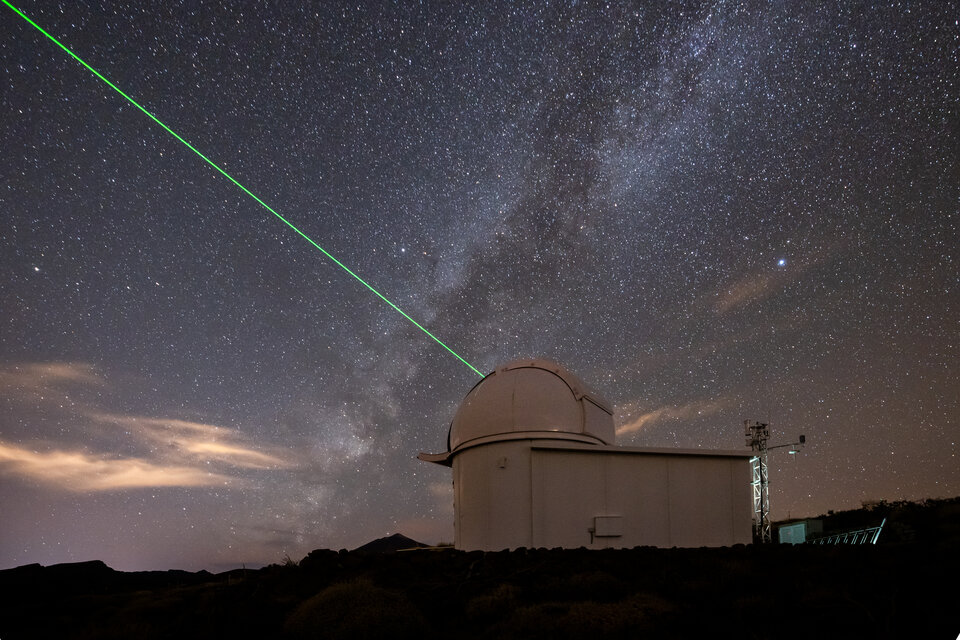
Setting community standards
Getting a better view on the problem through space debris tracking and reporting is just the first step in resolving the space debris problem.
ESA has set itself the goal to significantly limit the production of debris in Earth and lunar orbits of all future missions, programmes and activities by 2030 through its Zero Debris Approach. ESA is leading by example as it works on many activities in parallel as part of this holistic approach:
- ESA has updated its debris mitigation requirements and standards that govern how the Agency's missions are designed, built, flown and disposed of, also setting the rules for any company or institution that works with ESA on its missions.
- Stricter debris mitigation guidelines are welcomed by many in the space sector and shows itself in the increasing wave of community-driven activities. In 2023, ESA facilitated the creation of the Zero Debris Charter by the Zero Debris community in Europe. The Charter has since been signed by 12 countries and over 100 commercial and non-commercial entities have signed or committed to sign as well.
Zero-debris development
- ESA is now supporting the next step, the creation of a Zero Debris Technical Booklet, bringing together the many stakeholders in the space sector to crowd-source technical solutions to achieve the joint aspirations defined in the Zero Debris Charter.
- ESA also works directly on technology and capability development to prevent and counteract space debris, enabling and stimulating European industry to pioneer in-space sustainability solutions.
- A number of missions are in development at ESA and its partners to actively combat the generation of debris, such as through developing new passivation techniques, preventing in-orbit break-up and conducting in-orbit servicing.
Cleaning up orbits
Even if we created no new space debris, it would not be enough to prevent a runaway series of collisions and fragmentations. We must also clean up littered orbits by attempting to safely reenter missions already in orbit and conduct active debris removal via missions such as ESA's ClearSpace-1.
Where possible, ESA is attempting to deorbit satellites that were designed and built well before its current guidelines came into effect. The agency is putting great effort into removing missions such as Aeolus and Cluster from orbit in more sustainable ways than were first envisioned.
Read the full ESA 2024 Annual Space Environment Report
9th European Conference on Space Debris
Want to help address the challenges of space debris? The 9th European Conference on Space Debris will take place at the World Conference Center Bonn, Germany, on 1—4 Apr 2025. Abstract submission opens on 1 October 2024. Participant registration opens on 1 November 2024.
Organised by ESA’s Space Debris Office, the conference is the largest dedicated gathering on the subject. Scientists, engineers, operators, industry experts, lawyers and policy makers from around the world will meet in Bonn to discuss different aspects of space debris research, including measurement techniques, environment modelling theories, risk analysis, mitigation, remediation and regulation.















 Germany
Germany
 Austria
Austria
 Belgium
Belgium
 Denmark
Denmark
 Spain
Spain
 Estonia
Estonia
 Finland
Finland
 France
France
 Greece
Greece
 Hungary
Hungary
 Ireland
Ireland
 Italy
Italy
 Luxembourg
Luxembourg
 Norway
Norway
 The Netherlands
The Netherlands
 Poland
Poland
 Portugal
Portugal
 Czechia
Czechia
 Romania
Romania
 United Kingdom
United Kingdom
 Slovenia
Slovenia
 Sweden
Sweden
 Switzerland
Switzerland



























